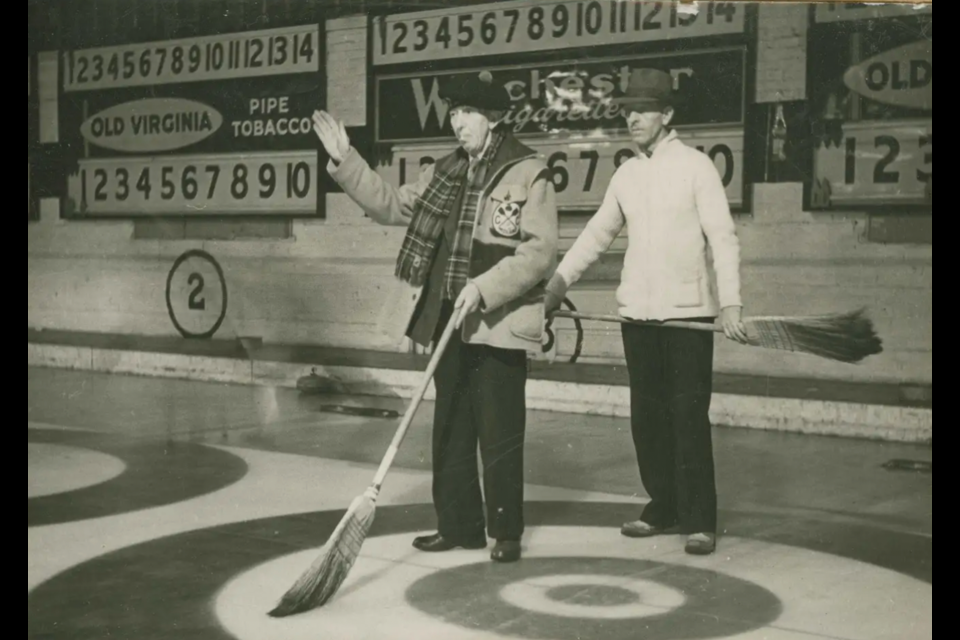“It’s not just an old person’s game,” says Lynn Morton, past-president of the Ladies Section at the Midland Curling Club.
The Midland Curling Club celebrated its Centennial recently, and, with 100 years of history behind it, there’s a lot to appreciate.
Morton and her family have a long history at the club, and she beams with pride as she explains that her family has curled at the Midland club for five generations. In the 1980s she took the ice with three generations of her family — grandmother, mother, herself — and she wouldn’t have it any other way.
“My grandmother and grandfather curled at the club, and now my children, and my grandson curl there,” says Morton. “There isn’t another family that has five generations of curlers at the club.”
In 1963, when Morton started curling at the Midland Club, there was a separate Ladies Section. There were even divisions for business ladies, who worked and couldn’t curl during the day.
Since the club’s current president is a woman, and it’s past-president is also a woman, Karen Mallany, it’s hard to imagine a time when the playing surface was less even.
It wasn’t until 1945 that ‘mixed’ curling began at the club with the formation of the Ontario Ladies Curling Association. Until then, men’s and ladies curling were separate events. Interestingly, the Winter Olympics did not include mixed doubles curling until 2018.
It takes a lot of ice time to make it to the Olympics in curling, and one former ice-maker, and club manager, can lay claim to producing world champion curlers: Bill Howard.
Not only was Howard an expert ice-maker, but he also taught his sons, Russell and Glenn Howard, everything he knew about curling.
His two sons went on to become world-renowned curlers. Russ Howard won Olympic Gold in Turin in 2006, among many other titles, and Glenn Howard has won four world championships in the sport.
The legacy the Howards created in the sport started right here in Midland, where Bill took advantage of being the manager and ice-maker giving his sons more time to practice on the ice. And, it paid off in spades for the Howards, who are now known as the first family of curling.
Laying claim to a connection with curling royalty is not the only thing that makes Midland’s Curling Club historically significant.
Perhaps the secret to the success of the club’s curlers is in the long history of making sure there’s a high-quality surface to play on.
To look at the building today, you might never think that the club was once the only curling rink to have artificial ice between Toronto and Winnipeg at one time.
It was in 1933 that the club became the largest ice rink in the world to be refrigerated by one plant. The same plant provided ice for the old skating arena and the curling club. At the time, the cooling system ran thirteen miles of pipe and covered 24,000 square feet.
Today, while the cooling system is somewhat smaller, it is part of what makes maintaining a curling club an expensive and ongoing process.
“Having a temperature-controlled building — that’s what cost so much money,” explains club past-president Karen Mallany.
For Morton, whose father was also an ice-maker at the club, you can’t put a price on well-made ice.
“We have one of the best ice-makers. He schooled himself,” says Morton while boasting about Bryan Wilson, the current ice-maker in Midland. At one time, Wilson maintained the ice surfaces in Elmvale, Coldwater, Penetanguishene, and Midland.
Morton notes that over the years everything from the ice to the rocks, the brooms, and even the shoes you wear have changed. It’s made the sport more dynamic, and accessible to a larger audience, including kids.
Given that Canada’s current Olympic hopefuls are battling for gold in China, Morton points out that the rocks themselves have changed a lot. Years ago, you had to own your own rocks, and they weighed 50 pounds. Curling rocks today weigh in at about 40 pounds, and it’s definitely changed the game.
Even the way the rocks are thrown has changed, adds Mallany. While it is still called ‘throwing,’ the rocks seldom leave the ice before they’re sent down the line.
“It saves injuries by changing the way you move your body,” says Mallany who is relatively new to the sport, and started curling in 2009.
Mallany runs the Learn to Curl program, and before the COVID-19 pandemic, she was always happy to see the local school kids come in with their phys-ed programs to learn to curl.
Junior curlers were called the Little Rocks, and the club hopes to have that league start up again soon.
“People of any age can curl, and if you start young, you can develop your skill level, and you can carry it right through into your later years,” says Morton, the curling enthusiast.
Mallany and Morton both agree on the longevity of the sport for the average curler, as they both mention the club’s oldest curler, Joe Ogden, who is still on the ice at 93 years old.
With a curler still on the ice today that’s nearly the same age as the club, you have to agree the sport has appeal. Maybe that’s the secret to a long life: throw rocks, and hurry hard while you sweep your way to good times curling.
If you’re interested in becoming a person with a broom, and learning to curl, visit www.midlandcurlingclub.com or call (705) 526-5631. The Midland Curling Club is located at 474 King Street in Midland.



